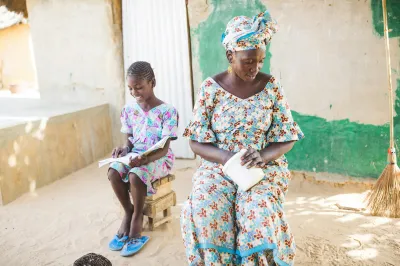Break the Bias: Evidence Shows Digital Finance Risks Hit Women Hardest
When Kabamba heard that thieves had broken into her grandmother’s house and stolen the cash in her bedroom, she knew her grandmother needed money — and fast. Without cash on hand, her grandma wouldn’t be able to restock her small business selling tomatoes. She might have to close down. Kabamba sent 1,000 Zambian kwacha (about US$60) via digital transfer, expecting the money to reach her grandmother many kilometers away in a matter of moments. However, after Kabamba sent the money, her grandmother experienced a different, more insidious form of theft.
Kabamba paid a standard bank transfer charge of K 15 but was shocked that her grandmother only received K 700 of the K 1,000 transfer. Kabamba’s grandmother explained that the mobile money agent withheld K 300 for “service fees.” Kabamba advised her grandmother to warn the agent that she would report the incident to the relevant authorities. Kabamba’s grandmother confronted the agent, who owned up and paid back the difference. Because of this incident, Kabamba’s grandmother is no longer confident using mobile money services without help from trusted relatives.
Agent fraud like this is just one of the many types of risks that digital financial service (DFS) users, especially women, face around the world today. Over the past year, CGAP has been studying the evolving nature of DFS consumer risk globally since 2015. In our recently published typology of 66 DFS consumer risks, we find that not only are long-standing risks like agent fraud getting worse, but new risks are emerging every year. Women like Kabamba’s grandmother are particularly vulnerable to these risks.
This has significant consequences for women’s financial inclusion. In addition to causing women financial hardship, experiencing or hearing stories of women who have experienced consumer risks can discourage women from using mobile money — the main driver of financial inclusion in many developing countries, particularly in Sub-Saharan Africa. Negative experiences with DFS can also force women to revert to informal finance mechanisms, reversing progress in financial inclusion.
Women are more vulnerable to DFS risks than men
Emerging evidence shows that women are more likely to experience most risks identified in CGAP’s consumer risk typology. For instance, a Columbia University study found that women DFS users in Africa and South Asia are more vulnerable than men to cyber-fraud, particularly social engineering scams such as SMS and voice phishing. Another study in rural Ghana revealed that female mobile banking customers were relatively more likely to suffer misconduct than male customers. There is also evidence that women are twice as likely to have their identity stolen and are at a higher risk of online harassment than men.
In a world where women have lower digital access than men, women are also more likely to experience algorithmic bias since men are better represented in the datasets that train the algorithms.
Lower digital and financial skill levels among factors that make women more susceptible to DFS consumer risks
A few factors heighten women’s susceptibility to DFS risks. One of the most important is that women generally have lower digital and financial skills than men.
The Economist Intelligence Unit estimates that in Sub-Saharan Africa, men are 30% more likely than women to be connected to the internet. In all 14 countries covered by GSMA’s Intelligence Consumer Survey, more women than men cited not knowing how to use a phone as one of the main barriers to owning a mobile phone. Also, findings from six country deep dives indicate that men are more digitally and financially literate than women. While the global financial literacy gender gap is 5% according to the S&P Global Financial Literacy Survey, many countries, both developed and developing, have much larger gaps.
In the context of the COVID-19 pandemic, the gender gap in digital and financial literacy has put women at even greater risk. The pandemic has accelerated the world’s digital transformation, led to a surge in digital fraud and compelled women to use DFS even when their digital and financial skills are low.
Sometimes, poor communication from governments and DFS providers to agents and customers adds to the problem. In Indonesia, bank agents and facilitators of the Program Keluarga Harapan held incorrect beliefs about accounts used to receive government-to-person (G2P) payments. These included the idea that “any money left in the account will be taken back by the bank.” This led many women to mistrust and fear their G2P accounts. Unfortunately, women do not usually report issues of misinformation and misconduct due to complex redress procedures.
In many countries, social norms discourage women from engaging freely with male agents, preventing them from asking questions about product features. In Bangladesh, the IFC found that women believed that female agents were “better behaved,” easier to approach, more trustworthy and better at maintaining confidentiality than male agents. Breaking the bias in gender norms is crucial for promoting women’s digital financial inclusion, which helps women to generate income, access essential services, and protect their basic living standards.
Regulators, supervisors, funders and providers can help mitigate DFS consumer risks for women
Consumer risks warrant urgent action from to ensure positive outcomes for women and vulnerable DFS users. There has been notable progress on this front in recent years. For example, the IMF's Financial Access Survey shows that by October 2021, 71 of 165 jurisdictions reported gender-disaggregated data — an increase of 10% relative to the previous round.
Policy makers and regulators have also been focusing more on DFS risks. It is encouraging to see that 28% of the 43 central banks that participated in a recent AFI survey are adding consumer protection provisions to DFS-specific regulatory instruments. Also noteworthy is that 9% have designed a specialized consumer protection framework for DFS, and 12% are considering gender-based risk issues.
Many funders have also taken proactive steps to promote responsible access and usage of DFS. For instance, the International Finance Corporation, together with CDC, KfW, Goodwell Investments and 50 co-founding signatories, launched the Investor Guidelines for Responsible Investing in DFS. However, there is room to further emphasize gender.
To improve gender-disaggregated data and mitigate DFS consumer risks for women, we suggest the following:
- Regulators and supervisors can require financial services providers to report gender-disaggregated consumer risk data. They can also monitor gender-based risks using the tools described in CGAP’s Market Monitoring Toolkit, like mystery shopping, thematic reviews and phone surveys. A United Nations Secretary-General’s Special Advocate for Inclusive Finance for Development study in 2020 found that countries with more experience gathering supply-side, gender-disaggregated data developed gender-informed financial policies. Collecting consumer risk data can help regulators and supervisors to design appropriate consumer protection regulations that promote women’s financial inclusion.
- Funders can finance programs that elevate women’s voices. For example, they can support consumer associations, which are chronically under-resourced. Some consumer associations have helped to promote women’s financial capability. The Consumer Council of Zimbabwe rolled out financial education programs to 4,000 women through consumer action clubs. Consumer Unity and Trust Society International supported 84,000 women with financial literacy activities, while the Consumer Council of Fiji provided financial advisory services to women. Funders can also promote programs that enhance women’s financial and digital literacy.
- Providers can take a more customer-centric approach with women. This may require them to adapt their culture and business models to better serve women. At a minimum, they should better understand women’s needs — for instance, by investing in consumer insights research and analyzing internal customer data. In Bangladesh, a simple redesign of Grameenphone’s utility bill and mobile top-up app, GPAY, simplified the user interface. This made it easier for less digitally literate women to use the payment solution.
By taking these steps, we can help ensure women like Kabamba’s grandmother use DFS to achieve positive financial outcomes.
For more information about DFS consumer risks and additional recommendations on mitigating them, see CGAP’s new report, “The Evolution of the Nature and Scale of DFS Consumer Risks: A Review of Evidence.”




Add new comment